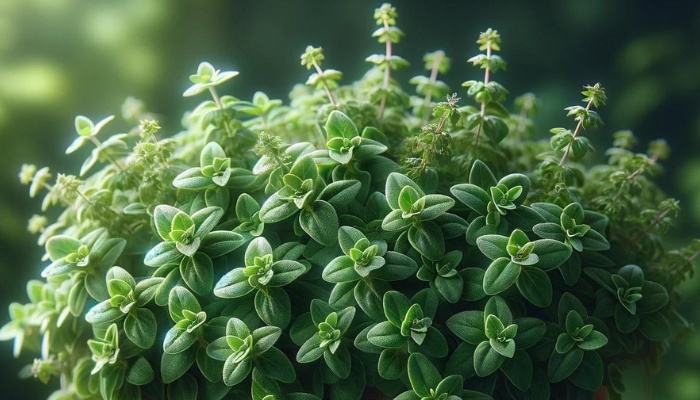To start growing oregano in your square foot garden, you’ll need a spot with 6 to 8 hours of direct sunlight and a soil pH between 6.0 to 7.0. Test and adjust the soil’s pH using garden lime or sulfur as necessary.
Plant high-quality, disease-resistant oregano seeds 1/4 inch deep, ensuring they’re not overcrowded. Water them lightly but consistently for optimal moisture.
Oregano requires well-drained, loamy soil, so incorporate compost or manure to improve soil structure. Provide regular care, monitoring water needs and watching for pests. Harvest before flowering for the best flavor.
With these steps, you’ll foster thriving oregano plants that enhance your garden’s biodiversity and culinary offerings.
Choosing the Perfect Spot
Selecting an ideal location for your oregano involves ensuring the spot receives at least six to eight hours of direct sunlight daily, as this herb thrives in well-lit environments.
Oregano prefers a soil pH between 6.0 and 7.0, which is mildly acidic to neutral. You can easily test the soil’s pH with a kit from your local gardening store.
Adjusting the pH might be necessary to create optimal growing conditions. Adding garden lime can raise the pH if it’s too acidic, and incorporating sulfur can lower it if it’s too alkaline.
Oregano thrives in well-drained, loamy soil. To achieve this, you’ll need to incorporate soil amendments.
Mix in compost or well-rotted manure to improve soil structure and nutrient content. This organic matter not only enhances drainage but also provides essential nutrients for your oregano plants.
Companion planting can significantly enhance your oregano’s growth and yield. Planting oregano near tomatoes, for instance, not only improves the flavor of both plants but also helps repel pests naturally due to oregano’s strong scent.
However, avoid placing oregano too close to plants that prefer more acidic soils, such as blueberries, since their soil requirements clash.
This strategic placement ensures your oregano benefits from and contributes to a harmonious garden ecosystem.
Planting Oregano Seeds
It’s important to plant oregano seeds at the optimal depth and spacing to ensure their best growth potential. Begin with seed selection, choosing high-quality, disease-resistant oregano seeds to promote a healthy start.
Oregano seeds thrive when planted at a shallow depth, approximately 1/4 inch beneath the soil surface because they require ample light for the germination process to initiate effectively.
Scatter the seeds lightly across the prepared square foot, ensuring they’re not clustered too closely. This prevents competition for resources later on.
After sowing, gently press the seeds into the soil without burying them too deep, covering lightly with a fine layer of soil or vermiculite to maintain moisture without obstructing light penetration.
Oregano’s germination process is sensitive to moisture levels, requiring a balanced approach. Water lightly but consistently, keeping the soil moist without causing waterlogging, which can hinder seed germination and encourage fungal diseases.
Under optimal conditions, expect germination to occur within 7 to 14 days.
Ongoing Care and Maintenance
Focusing on your oregano’s ongoing care and maintenance ensures robust growth and abundant harvests.
Oregano, being a Mediterranean herb, thrives in conditions that replicate those climates—well-draining soil, full sun, and moderate to low water.
The key to healthy oregano plants lies in understanding their watering needs. Watering frequency should be moderated; too much water can lead to root rot, but too little can stress the plant. Aim for moist, not waterlogged, soil.
Typically, watering deeply once a week should suffice, but this can vary based on your local climate and weather conditions.
Pest control is another critical aspect of oregano care. While oregano is relatively hardy and resistant to many pests, it’s not invulnerable.
Regular inspections for common garden pests such as aphids and spider mites are essential.
If pests are detected, consider using natural remedies, such as neem oil or a mild soap solution, to manage them without resorting to harsh chemicals that can harm beneficial insects or your garden’s ecosystem.
Harvesting Your Oregano
The peak moment to harvest oregano is just before the plant flowers, when the leaves are packed with essential oils and offer the most intense flavor.
To capture this, aim for a morning harvest after the dew has evaporated but before the sun is fully high. This timing reduces moisture content while preserving those aromatic oils.
Once you’ve picked your oregano, consider drying methods for long-term storage. Air drying is the most traditional approach and is ideal for preserving the herb’s potent oils.
Bundle your oregano stems, and hang them upside down in a well-ventilated, dry space away from direct sunlight. This method ensures a slow, even drying process, retaining the herb’s quality.
For quicker drying, you might opt for a food dehydrator set at a low temperature. This method is more controlled, reducing the risk of mold and maintaining flavor integrity.
Once dried, crumble your oregano leaves, discarding the stems. Store them in an airtight container in a cool, dark place. Glass jars work best, shielding your oregano from moisture and ensuring your harvest remains potent for months to come.

